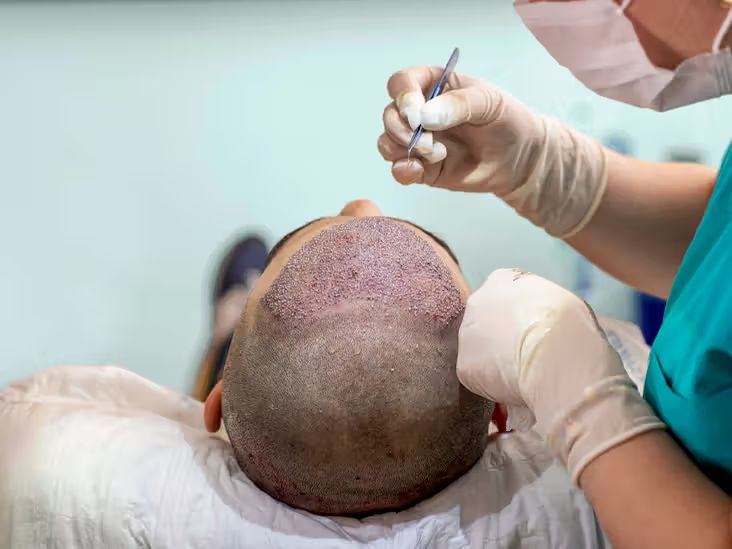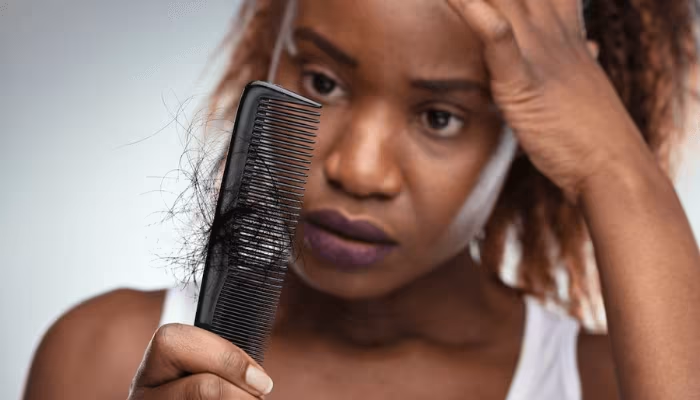Experiencing hair loss can significantly impact one’s self-confidence and daily social interactions.
As thinning spots become more noticeable, many individuals seek effective solutions to restore their appearance and confidence.
Two of the most common options are wigs (including hair systems) and hair transplants—each offering distinct advantages and potential drawbacks.
This comprehensive guide explores both options in detail to help you make an informed decision based on your specific needs, lifestyle preferences, and long-term goals.
Understanding Hair Loss Solutions
Before diving into the comparison, it’s important to understand what each option entails and how they fundamentally differ in their approach to addressing hair loss.
Read more: The Ultimate Guide to Hair Transplants in Singapore
What is a Wig?

A wig (or hair prosthesis) is a non-surgical hair replacement option designed to cover bald spots or thinning areas on the scalp.
Modern wigs are custom-made to fit the wearer’s cranial measurements and can be crafted from either real human hair or high-quality synthetic fibers.
Permanent wigs are secured to the scalp using medical-grade adhesive that typically requires replacement every six to eight weeks.
With proper care, a quality wig can last between six to twelve months before needing replacement.
This might be helpful: Which Hair Transplant Clinic in Singapore Should You Consider? (Sort by Reviews)
What is a Hair System?
While often used interchangeably with “wig,” a hair system refers to a more specialized, customized non-surgical hair replacement solution.
Hair systems are meticulously crafted to mimic the appearance and feel of natural hair and are designed to be securely attached to the scalp through adhesives, tapes, or specialized clips.
The key difference is that hair systems are typically custom-made for each individual—precisely cut, colored, and styled to blend seamlessly with the wearer’s remaining natural hair or to fully replace hair in cases of complete baldness.
Read more: Hair Loss Treatment in Singapore
What is a Hair Transplant?

A hair transplant is a surgical procedure that involves moving hair follicles from one area of the body (typically the back or sides of the head, known as the “donor area”) to the thinning or balding areas.
The most common technique is Follicular Unit Extraction (FUE), where individual hair follicles are carefully extracted and implanted into small incisions in the target areas.
Once transplanted, these follicles establish themselves and begin to grow hair naturally, providing a potentially permanent solution to hair loss.
You might like: Best Hair Loss Clinic in Singapore
Comparing Wigs and Hair Systems to Hair Transplants
To help you determine which option better suits your needs, let’s examine the key factors that differentiate these solutions.
Effectiveness and Appearance
Wigs and Hair Systems:
Wigs and hair systems provide immediate coverage of bald or thinning areas and can be styled to achieve the desired appearance.
Quality varies significantly based on materials and construction, with high-end custom systems capable of looking remarkably natural.
However, they may have a detectable hairline if not properly fitted by experienced professionals.
Hair Transplants:
Hair transplants produce results that develop gradually over six to twelve months after the procedure.
Transplanted hair grows naturally and can be treated like natural hair in all respects.
When performed by skilled surgeons, results can be virtually undetectable and create a permanent natural hairline. However, results may be limited by the availability of donor hair from the patient.
You might be interested: FUE Hair Transplant in Singapore: Cost, Reviews, Risks
Duration and Permanence
Wigs and Hair Systems:
Wigs and hair systems are temporary solutions requiring regular replacement, with permanent wigs typically lasting six to twelve months.
Adhesives need replacement every six to eight weeks, making this ongoing maintenance rather than a permanent solution to hair loss.
Hair Transplants:
Hair transplants are considered a permanent solution where transplanted follicles continue to produce hair for years or decades.
Additional sessions may be required if hair loss progresses in untreated areas, but results typically last for many years or even a lifetime with proper care.
Comfort and Lifestyle Considerations
Wigs and Hair Systems:
Wigs and hair systems may feel uncomfortable, especially in hot weather, and can cause scalp irritation for some wearers.
They present limitations during sleeping and showering, and users often have concerns about security during physical activities. Regular adjustments and maintenance are required, though they do allow for versatility in changing styles and looks as desired.
Hair Transplants:
Hair transplants feel completely natural after healing since the hair is your own. There are no restrictions on sleeping, showering, or physical activities once recovery is complete.
No maintenance is required beyond normal hair care, though the hair cannot be removed or changed if style preferences change. The result is limited to one natural look, though it can be cut and styled like normal hair.
Cost Comparison
Wigs and Hair Systems:
Wigs and hair systems require a lower initial investment but involve recurring costs for replacements and maintenance.
Quality systems typically range from $1,000 to $3,000 or more per year, with additional costs for styling, cleaning, and adhesive replacement creating ongoing financial commitments.
Related article: Regenera Activa Singapore: Benefits, Risks, Costs
Hair Transplants:
Hair transplants involve a higher upfront cost, typically ranging from $4,000 to $15,000 or more depending on the extent of treatment and location.
This is typically a one-time investment, though possible additional costs may occur if multiple procedures are needed.
There are no ongoing maintenance costs beyond normal hair care once the procedure is complete and healed.
Recovery Process
Wigs and Hair Systems:
The recovery process differs significantly between wigs and hair systems versus hair transplants, making this an important consideration when choosing between options.
Wigs and hair systems require no recovery time and can be worn immediately without any physical side effects or healing period required.
This makes them an ideal solution for those who need immediate results or cannot take time off for recovery.
Hair transplants require a recovery period of one to two weeks, during which patients experience initial redness and swelling at the treatment sites.
There are potential risks of infection, bleeding, or scarring that must be considered. Complete results are not visible for six to twelve months as the transplanted hair gradually grows and matures.
You might like: Guide to Finding a Good Aesthetic Doctor in Singapore
Who Is an Ideal Candidate for Each Option?

Understanding which solution best fits your situation depends on various factors including the cause and extent of hair loss, budget considerations, and personal preferences.
Ideal Candidates for Wigs and Hair Systems
Individuals with temporary hair loss due to medical treatments often find wigs and hair systems most appropriate for their needs.
Those with extensive baldness who have limited donor hair available for transplantation benefit from these non-surgical options.
People seeking an immediate solution without recovery time find wigs particularly appealing.
Individuals with medical conditions that prevent surgery must consider non-surgical alternatives, as do those with unpredictable or patchy hair loss patterns such as alopecia areata.
People who want the flexibility to change their hairstyle frequently appreciate the versatility that wigs offer. Additionally, individuals who cannot afford the upfront cost of a hair transplant may find wigs a more accessible option.
Ideal Candidates for Hair Transplants
Those with stable hair loss patterns, typically male or female pattern baldness, are generally good candidates for hair transplants. Individuals must have sufficient donor hair available for the procedure to be successful.
People seeking a permanent, maintenance-free solution often prefer the long-term benefits of transplantation.
Those who can afford the upfront investment and are healthy enough to undergo surgery make suitable candidates. Individuals who have realistic expectations about results and are willing to wait for the final results to develop over many months are most likely to be satisfied with hair transplant outcomes.
Different Types of Wigs and Hair Systems
Understanding the various options available can help you make a more informed decision if you’re leaning toward a non-surgical solution.
By Material
Human Hair Wigs:
Human hair wigs are created from real human hair, providing the most natural look and feel possible.
They can be styled, colored, and treated like natural hair, though they require more maintenance and care than synthetic alternatives.
While more expensive than synthetic options, they typically last longer with proper care and provide superior aesthetic results.
Synthetic Hair Wigs:
Synthetic hair wigs are made from artificial fibers and come pre-styled, holding their style well over time.
They have lower maintenance requirements and are more affordable options for many people.
However, they offer less natural appearance and feel compared to human hair and generally have a shorter lifespan than human hair wigs.
By Construction
Full Wigs:
Full wigs cover the entire head and are ideal for extensive hair loss, available in various cap constructions to suit different needs and preferences.
Partial Wigs/Hairpieces:
Partial wigs and hairpieces cover specific areas of thinning and blend with existing hair, offering less comprehensive coverage but often providing more comfort for those with partial hair loss.
Lace Front Wigs:
Lace front wigs feature a transparent lace front that creates a natural-looking hairline, producing the illusion of hair growing directly from the scalp for more realistic appearance.
Monofilament Wigs:
Monofilament wigs include a thin, breathable material at the top that allows for multidirectional parting while creating the appearance of hair growing from the scalp.
These designs are more comfortable and natural-looking than traditional construction methods.
Different Types of Hair Transplant Procedures
If you’re considering a surgical approach, there are several techniques available, each with its own advantages.
Follicular Unit Extraction (FUE)
FUE involves extracting individual follicular units one by one, resulting in minimal scarring that appears as tiny dot scars.
This technique offers quicker recovery time and less post-operative pain compared to other methods.
It’s particularly suitable for those who want to wear their hair short, though the procedure is more time-consuming and typically more expensive than other options.
Follicular Unit Transplantation (FUT)
FUT involves removing a strip of skin containing hair follicles, after which follicular units are separated and transplanted to the recipient area.
This method leaves a linear scar at the donor site but allows more grafts to be harvested in a single session. It’s typically less expensive than FUE but requires a longer recovery time for optimal healing.
Direct Hair Implantation (DHI)
DHI is similar to FUE but uses a specialized implanter tool that allows for more precise placement of hair follicles.
This technique can achieve higher density results but is typically more expensive than standard FUE procedures. The precision offered by DHI can lead to more natural-looking results in skilled hands.
Special Considerations for Medical Hair Loss
Hair loss due to medical conditions or treatments requires special consideration, as these situations often have unique characteristics and needs.
Hair Loss from Chemotherapy
Cancer treatments frequently cause temporary but significant hair loss. For patients undergoing chemotherapy:
- Wigs offer an immediate solution during treatment
- Can help maintain privacy about medical condition
- Allow for a sense of normalcy during recovery
- Hair typically regrows after treatment concludes
- Medical-grade wigs may be partially covered by insurance
Alopecia Areata and Other Autoimmune Conditions
These conditions can cause unpredictable, patchy hair loss patterns:
- Wigs and hair systems provide reliable coverage despite unpredictable loss
- Allow for consistent appearance despite changing patterns of loss
- Can be adjusted as conditions fluctuate
- Transplants may be less effective due to the autoimmune nature of the condition
Post-Surgical Hair Loss
Some medical procedures involving the scalp may result in hair loss:
- Temporary wigs can provide coverage during healing
- Transplants may be considered after full recovery
- Consultation with both the surgeon and hair restoration specialist is recommended
Making Your Decision: Key Factors to Consider
When deciding between wigs, hair systems, and hair transplants, consider the following:
Level of Hair Loss
- Extent and pattern of baldness
- Stability of hair loss (is it continuing to progress?)
- Availability of donor hair if considering a transplant
Budget Considerations
- Initial investment capability
- Long-term cost analysis
- Insurance coverage possibilities (especially for medical hair loss)
Lifestyle Factors
- Physical activity level
- Swimming or water exposure frequency
- Professional appearance requirements
- Styling preferences and versatility needs
Time Factors
- Immediacy of results needed
- Ability to accommodate recovery time
- Long-term commitment to maintenance
Medical Suitability
- Underlying conditions that may affect options
- Scalp health and sensitivity
- Medical treatments that might impact results
Maintenance and Care
Each solution requires different levels of care and maintenance to ensure optimal results and longevity.
Wig and Hair System Maintenance
- Regular cleaning using specialized products
- Periodic professional styling
- Adhesive replacement every 6-8 weeks
- Complete replacement every 6-12 months
- Protection from excess heat and harsh chemicals
- Special storage when not being worn
Hair Transplant Aftercare
- Initial specialized care during healing (first 2 weeks)
- Avoiding strenuous activity during recovery
- Following surgeon’s instructions for washing
- Protection from sun exposure during healing
- Regular check-ups with the surgeon
- Normal hair care once fully healed
The Psychological Impact of Hair Restoration
Beyond the physical aspects, addressing hair loss can have significant psychological benefits. Studies have shown that effective hair restoration, whether through wigs, hair systems, or transplants, can:
- Increase self-confidence and positive self-image
- Reduce anxiety in social situations
- Improve quality of life measurements
- Reduce preoccupation with appearance
- Enhance career and relationship prospects
The right solution should not only address the physical aspect of hair loss but also support emotional well-being and confidence.
Consultation Process
Before making a final decision, consider consulting with specialists in both fields:
Wig and Hair System Consultation
- Assessment of hair loss pattern
- Discussion of material options
- Measurements for custom fitting
- Color and style matching
- Trial of different options
- Maintenance instruction
Hair Transplant Consultation
- Evaluation of donor hair availability
- Assessment of hair loss pattern and progression
- Discussion of realistic expectations
- Explanation of procedure options
- Recovery timeline planning
- Cost and financing options
Conclusion
Both wigs/hair systems and hair transplants offer viable solutions for addressing hair loss, each with distinct advantages and considerations.
Wigs and hair systems provide immediate, non-surgical options with flexibility and lower initial costs, while hair transplants offer a potentially permanent solution that requires no ongoing maintenance.
The best choice depends on your specific situation, including the cause and extent of hair loss, budget considerations, lifestyle preferences, and long-term goals.
For many individuals, the journey may include both options—perhaps using a wig or hair system temporarily while considering or saving for a transplant, or using a hairpiece to supplement areas where transplantation was limited.
Remember that addressing hair loss is a personal journey, and the right solution is the one that helps you feel most confident and comfortable.
FAQ Section
What is the average cost of a quality wig versus a hair transplant?
Quality wigs typically range from $1,000 to $3,000, with human hair options at the higher end of the spectrum.
Additionally, maintenance costs include adhesive replacement and periodic professional styling.
A hair transplant in most regions costs between $4,000 and $15,000, depending on the number of grafts needed and the technique used. While transplants have a higher upfront cost, they don’t require the ongoing expenses associated with wigs.
How long does it take to see results from a hair transplant?
After a hair transplant procedure, patients typically notice three phases: initial growth, shedding, and permanent growth.
The transplanted hair usually falls out within 2-3 weeks after the procedure (a normal part of the process called “shock loss”).
New growth typically begins around the 3-4 month mark, with significant results visible by 6-8 months. Full results are generally apparent 12-18 months after the procedure as the hair continues to thicken and mature.
Can I shower, swim, or exercise with a wig or hair system?
With standard wigs, showering and swimming are typically not recommended as water exposure can damage the wig and loosen adhesives.
However, specialized sport wigs and waterproof hair systems are available for active individuals.
These systems use stronger adhesives and waterproof bases that allow for swimming and intense physical activity, though they still require more careful maintenance. Hair transplants, once healed, allow for completely unrestricted activities.
Will a hair transplant work for everyone?
Hair transplants are not equally effective for all individuals. The best candidates have:
- Stable hair loss (not rapidly progressing)
- Sufficient donor hair density
- Good hair texture (thicker hair provides better coverage)
- Realistic expectations about results Individuals with diffuse thinning throughout the scalp, those with very limited donor hair, or those with certain scalp conditions may not be ideal candidates. Women with female pattern hair loss may have different patterns that make transplantation more challenging in some cases.
How noticeable is a wig or hair system to others?
The detectability of a wig or hair system depends significantly on quality, fit, and installation.
High-quality, custom-made systems constructed with human hair and features like lace fronts and monofilament tops are much less detectable than off-the-shelf options. Proper installation by a professional significantly improves natural appearance.
While close inspection might reveal even the best systems, modern premium hair replacements are remarkably natural-looking in everyday interactions when properly fitted and maintained.
Is a hair transplant painful?
Hair transplant procedures are performed under local anesthesia, so patients don’t feel pain during the actual surgery. Most patients report feeling pressure or mild discomfort rather than pain.
Post-procedure discomfort varies among individuals, with most describing it as mild to moderate for the first 2-3 days. Pain medication is typically prescribed for this initial recovery period.
The donor area may feel tender for about a week, while the recipient area generally heals with minimal discomfort after the first few days.
Can I style, color, or heat-treat my wig or transplanted hair?
Human hair wigs can be colored, styled, and heat-treated much like natural hair, though these processes can shorten the wig’s lifespan.
Synthetic wigs have significant limitations with heat styling and cannot be colored. Specialized heat-friendly synthetic wigs exist but still have temperature limitations.
Transplanted hair, once fully established (after about 6 months), can be treated exactly like your natural hair—it can be cut, colored, permed, and styled with heat tools since it is your living hair growing from relocated follicles.
How do I sleep with a wig or hair system?
Sleeping with a permanently attached hair system is possible, though it may cause more wear and tear. Many users choose to:
- Use a silk or satin pillowcase to reduce friction
- Wrap the hair in a loose cap or scarf
- Consider a specialized sleeping cap designed for wig wearers Some prefer to have two systems—one for daily wear and a lighter “sleep cap” for nighttime. Non-permanent wigs should generally be removed for sleeping to preserve their appearance and extend their lifespan.
Will my insurance cover either wigs or hair transplants?
Insurance coverage varies significantly by provider and policy. Some health insurance plans may cover wigs (often called “cranial prostheses” in insurance terminology) when hair loss is due to medical conditions or treatments like chemotherapy.
Hair transplants are typically considered cosmetic procedures and rarely covered by insurance, except in cases of hair loss due to injury or burns. Always check with your specific insurance provider and consider requesting a letter of medical necessity from your doctor if your hair loss is medically related.
What happens if I’m not satisfied with my hair transplant results?
If you’re unsatisfied with hair transplant results, several options are available to address your concerns and potentially improve outcomes.
Waiting for full maturation is often the first recommendation, as results continue to improve for up to eighteen months following the procedure.
Consulting with your surgeon about a possible revision or second procedure can help determine if additional transplantation would benefit your specific situation.
Considering supplementary treatments like PRP (Platelet-Rich Plasma) to enhance growth may stimulate better results from existing transplanted follicles.
Using medical treatments like minoxidil or finasteride can help preserve and enhance results by supporting both transplanted and existing hair.
In some cases, using hairpieces to supplement areas where transplantation was limited can provide additional coverage while maintaining the benefits of the surgical procedure.
Most reputable surgeons offer follow-up consultations to address concerns and discuss options if the desired outcome wasn’t achieved.
This highlights the importance of choosing a qualified, experienced surgeon with a proven track record of successful outcomes and patient satisfaction.
How do I maintain my natural hair while wearing a wig?
To keep your natural hair healthy under a wig, several important care practices should be followed consistently.
Keep your scalp clean and moisturized to prevent buildup and irritation that can affect hair health. Allow your scalp to “breathe” when possible by removing the wig during times when coverage isn’t necessary.
Use a wig cap to protect hair and reduce friction between your natural hair and the wig material. Avoid tight braids or styles that can cause traction alopecia, which can worsen existing hair loss.
Consider gentle scalp treatments with essential oils or prescribed medications to maintain scalp health and support any remaining hair growth.
Stay hydrated and maintain good nutrition for overall hair health, as internal wellness significantly impacts hair quality.
Use satin or silk wig caps rather than nylon when possible, as these materials are gentler on hair and reduce breakage.
Consult with a dermatologist about specific scalp care regimens that complement wig wearing and address your individual needs.
Can I combine different hair loss solutions?
Yes, many individuals use combined approaches for optimal results, finding that multiple solutions work better together than any single treatment alone.
Common combinations include using a wig or hairpiece temporarily while waiting for transplant results to mature, providing immediate coverage during the lengthy growth period.
Supplementing a partial transplant with a hairpiece for additional density allows people to achieve fuller coverage than transplantation alone might provide.
Combining medical treatments like minoxidil or finasteride with either wigs or transplants can help preserve existing hair while addressing coverage needs.
Using cosmetic concealers or fibers to enhance the appearance of transplanted hair during the growth phase helps bridge the gap between procedure and full results.
Alternating between different solutions based on activities or occasions provides flexibility for varying lifestyle needs and social situations.
A comprehensive approach often yields the best results, especially for those with extensive hair loss who may benefit from multiple treatment modalities working together to achieve their desired appearance and confidence level.

